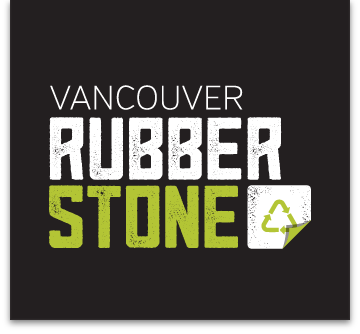What is it?
Rubber Stone is a recycled rubber based covering for either new, damaged or just plain ugly surfaces. It is made mainly from recycled rubber and solid synthetic rubber chips, combined with a flexible binding agent, which gives it durability, flexibility, and texture.
How ‘Environmentally Friendly’ is this product?
We live and work in one of the most beautiful places on earth, so the protection of the environment is dear to our hearts. For every 25 square feet of installed product you will keep 3 tires out of the landfill. So, for a typical double car driveway you will be keeping approximately 120 tires from the landfill!
Are all recycled rubber products the same?
No! Our rubber products are unique to us. They are specially selected from only a certain type of recycled rubber. High levels of quality control from the manufacturer ensure a smaller chip is produced which enable us to provide a tighter, higher quality installation.
Why are we so SPECIAL?
We like to think we are special! We use only the highest quality rubber available to us. Our colored rubber is a solid EPDM rubber chip from Switzerland. No ‘adding color on site’ for us, this ensures our colors will not scuff or wear off. All our installations are hand trowelled for the highest quality finish available, no mass production techniques and machines used here. By hand trowelling we ensure a tight, compacted, uniform finish which aids durability and looks great!
How versatile is it?
Very! Rubber Stone can be used for resurfacing concrete, paving stones, asphalt, wood and many, many more surfaces.
Why is it so durable?
Rubber Stone is as tough and durable as the tires on your vehicle, and this is enhanced by the strength and flexibility of a polyurethane binding agent.
Is it stain resistant?
Yes! Rubber Stone is stain resistant, and if it becomes icy it can be treated with ice-melting products such as salt.
What are the advantages to using this material indoors?
Rubber Stone is extremely durable but it is also soft to walk on and flexible. The polyurethane coating also creates an allergen-free surface as it prevents allergens from working into the material. Anything that falls on the floor can easily be cleaned away. This makes it perfect for play areas and exercise rooms, laundry rooms, or basement floors. Rubber Stone is also ideal for garage floors and shops where a lot of time is spent standing while you work.
What are the outdoor advantages to using this material?
Rubber Stone is commonly used to resurface concrete, but it also works well on paving stones, asphalt, and other substrates that are prone to movement. The flexibility of Rubber Stone allows it to conceal flaws and move with the surface it’s bonded to. In addition Rubber Stone offers slip resistance and a forgiving surface to land on if you happen to fall.
How versatile is Rubber Stone for design?
Rubber Stone is available in a wide variety of colors and can be applied artistically to create any variety of logos, numbers, pictures, or patterns.
What colors make up the Rubber Stone palette?
Our product comes in 7 main colors; black, brown, beige, blue, green, yellow, red, and grey. There are more than 20 variants of these colors available to our clients. The colored rubber chips aren’t dyed or tumbled. They are made of EPDM (Ethylene Propylene Diene Monomer) rubber, a solid synthetic rubber which will not fade or rub off over time.
Is Rubber Stone durable?
Extremely! Rubber Stone has been designed to withstand all of the temperature and climate extremes that occur throughout North America.
Can you repair Rubber Stone?
Rubber Stone is almost indestructible! But we have to be realistic—it is possible that Rubber Stone surfaces can incur damage. If movement occurs in the substrate, then it has to be expected that anything bonded to the substrate will also move. Rubber Stone is relatively flexible and can endure a certain amount of movement. However, extreme movement beneath the product may cause cracks to appear. When this happens cracks can be filled by adding more of the original product. Here’s the great thing: Repaired cracks in Rubber Stone are virtually invisible, unlike repairs to concrete.
How much maintenance is involved?
Well virtually none! However we recommend re-coating Rubber Stone with polyurethane every 7 years or so depending on the traffic usage. This will help ensure Rubber Stone stays bonded to the surface below.
